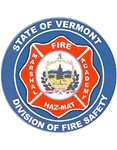Working smoke and carbon monoxide alarms are the most important device you can have in your home. They provide essential early warnings of a problem so you and your family can safely escape.
Requirements for carbon monoxide, or CO, detectors (alarms) went into effect in 2005 for all buildings where people sleep. Carbon monoxide (CO) is a deadly, colorless, odorless, poisonous gas. The only way to tell that it is present is to have a working CO alarm.
General Information -
CO Alarms General Information Sheet - Single Family Dwellings
Vermont State CO Alarm Law Title 9 Chpter77
Tampering with Smoke or CO Alarms sheet
Owner – Occupied Single Family Free Standing Dwellings
CO alarms are required to be installed in the vicinity of any bedrooms for all new dwellings and dwellings that are sold or transferred.
Carbon Monoxide alarms installed or replaced in a dwelling after July 1, 2005 must be directly wired to the building electrical service and have a battery backup.
One and Two family dwellings are allowed to use a plug in style alarm with battery backup.
Forms-
Smoke / CO alarm certification form used for home sales
CO Alarms Installation Matrix Sheet
Rental Units, Condos and Multi Family Dwellings or other Residential Public Buildings
The requirements for Carbon Monoxide alarms in Rental Units, Condos and Multi Family Dwellings or other residential buildings come out of Vermont fire and building safety codes. The Vermont fire and building safety code applies to “public buildings” that include any condominiums or multiple unit dwelling using a common roof, or row houses so-called, or other residential buildings in which people sleep, including hotels, motels, and tourist homes, whether the units are owned, leased or rented.
CO alarms are required to be installed in the vicinity of any bedrooms for all new dwellings and dwellings that are sold or transferred. Carbon Monoxide alarms installed or replaced in a dwelling after July 1, 2005 must be directly wired to the building electrical service and have a battery backup.
One and Two family dwellings are allowed to use a plug in style alarm with battery backup.
CO Alarms Installation Matrix Sheet
Request for Inspection of Public Building
Additional Information Resource Links
Carbon Monoxide - National Fire protection Association (NFPA)
Carbon Monoxide Poisoning - Center for Disease Control (CDC)
Carbon Monoxide safety alerts, guides, posters, brochures - Consumer Product Safety Commission (CPSC)
Carbon Monoxide Safety Outreach Materials - U.S. Fire Administration
CO Toxicology Information
Recent Recalls - CPSC Recalls
Responding to Residential Carbon Monoxide Incidents - CPSC - Guidance for the Fire Service
Vermont Dept of Health – CO Information

